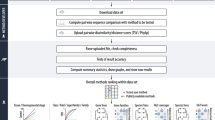Abstract
T-Coffee, for Tree-based consistency objective function for alignment evaluation, is a versatile multiple sequence alignment (MSA) method suitable for aligning virtually any type of biological sequences. T-Coffee provides more than a simple sequence aligner; rather it is a framework in which alternative alignment methods and/or extra information (i.e., structural, evolutionary, or experimental information) can be combined to reach more accurate and more meaningful MSAs. T-Coffee can be used either by running input data via the Web server (http://tcoffee.crg.cat/apps/tcoffee/index.html) or by downloading the T-Coffee package. Here, we present how the package can be used in its command line mode to carry out the most common tasks and multiply align proteins, DNA, and RNA sequences. This chapter particularly emphasizes on the description of T-Coffee special flavors also called “modes,” designed to address particular biological problems.
Access this chapter
Tax calculation will be finalised at checkout
Purchases are for personal use only
Similar content being viewed by others
References
Edgar RC, Batzoglou S (2006) Multiple sequence alignment. Curr Opin Struct Biol 16(3):368–373
Kemena C, Notredame C (2009) Upcoming challenges for multiple sequence alignment methods in the high-throughput era. Bioinformatics 25(19):2455–2465
Just W (2001) Computational complexity of multiple sequence alignment with SP-score. J Comput Biol 8(6):615–623
Notredame C (2007) Recent evolutions of multiple sequence alignment algorithms. PLoS Comput Biol 3(8):e123
Notredame C, Higgins DG, Heringa J (2000) T-Coffee: a novel method for fast and accurate multiple sequence alignment. J Mol Biol 302(1):205–217
Larkin MA et al (2007) CLUSTALW and CLUSTALX version 2.0. Bioinformatics 23:2947–2948
Di Tommaso P, Moretti S, Xenarios L, Orobitg M, Montanyola A, Chang JM, Taly JF, Notredame C (2011) T-Coffee: a Web server for the multiple sequence alignment of protein and RNA sequences using structural information and homology extension. Nucleic Acids Res 39(Web Server issue):W13–W17
Taly JF, Magis C, Bussotti G, Chang JM, Di Tommaso P, Erb I, Espinosa-Carrasco J, Kemena C, Notredame C (2011) Using the T-Coffee package to build multiple sequence alignments of protein, RNA, DNA sequences and 3D structures. Nat Protoc 6(11):1669–1682
Wallace IM, O’Sullivan O, Higgins DG, Notredame C (2006) M-Coffee: combining multiple sequence alignment methods with T-Coffee. Nucleic Acids Res 34(6):1692–1699
Chang JM, Di Tommaso P, Taly JF, Notredame C (2012) Accurate multiple sequence alignment of transmembrane proteins with PSI-Coffee. BMC Bioinformatics 13(Suppl 4):S1
O’Sullivan O, Suhre K, Abergel C, Higgins DG, Notredame C (2004) 3DCoffee: combining protein sequences and structures within multiple sequence alignments. J Mol Biol 340(2):385–395
Armougom F, Moretti S, Poirot O, Audic S, Dumas P, Schaeli B, Keduas V, Notredame C (2006) Expresso: automatic incorporation of structural information in multiple sequence alignments using 3D-Coffee. Nucleic Acids Res 34(Web Server issue):W604–W608
Siddharthan R, van Nimwegen E (2007) Detecting regulatory sites using PhyloGibbs. Methods Mol Biol 395:381–402
Arnold P, Erb I, Pachkov M, Molina N, van Nimwegen E (2012) MotEvo: integrated Bayesian probabilistic methods for inferring regulatory sites and motifs on multiple alignments of DNA sequences. Bioinformatics 28(4):487–494
Erb I, González-Vallinas JR, Bussotti G, Blanco E, Eyras E, Notredame C (2012) Use of ChIP-Seq data for the design of a multiple promoter-alignment method. Nucleic Acids Res 40(7):e52
Wilm A, Higgins DG, Notredame C (2008) R-Coffee: a method for multiple alignment of non-coding RNA. Nucleic Acids Res 36(9):e52
Kemena C, Taly JF, Kleinjung J, Notredame C (2011) STRIKE: evaluation of protein MSAs using a single 3D structure. Bioinformatics 27(24):3385–3391
Armougom F, Moretti S, Keduas V, Notredame C (2006) The iRMSD: a local measure of sequence alignment accuracy using structural information. Bioinformatics 22(14):e35–e39
O’Sullivan O, Zehnder M, Higgins D, Bucher P, Grosdidier A, Notredame C (2003) APBD: a novel measure for benchmarking sequence alignment methods without reference alignment. Bioinformatics 19(Suppl 1):215–221
Author information
Authors and Affiliations
Editor information
Editors and Affiliations
Rights and permissions
Copyright information
© 2014 Springer Science+Business Media, LLC
About this protocol
Cite this protocol
Magis, C. et al. (2014). T-Coffee: Tree-Based Consistency Objective Function for Alignment Evaluation. In: Russell, D. (eds) Multiple Sequence Alignment Methods. Methods in Molecular Biology, vol 1079. Humana Press, Totowa, NJ. https://doi.org/10.1007/978-1-62703-646-7_7
Download citation
DOI: https://doi.org/10.1007/978-1-62703-646-7_7
Published:
Publisher Name: Humana Press, Totowa, NJ
Print ISBN: 978-1-62703-645-0
Online ISBN: 978-1-62703-646-7
eBook Packages: Springer Protocols




